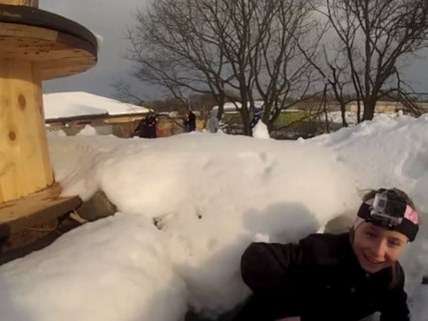Junkyard as Playground? Sounds Like More Fun Than a 'Safe' Childhood

When I was a kid, I used to roam the streets and woods with my friends, romping through construction sites as a diversion from the tube steel and asphalt playgrounds that were the norm for most of my childhood. I earned a few battle scars in the process, including a perfectly circular black eye from looking through a loose length of pipe at a buddy who unthinkingly nudged the other end. If you share a fondness for that kind of upbringing over eternal hovering over oh-so-precious wee ones who never seem to be allowed learn how to shake it off and get back into the mix, you'll enjoy Hanna Rosin's take on "The Overprotected Kid" at The Atlantic and alternatives thereto—including a playground seemingly modeled on a junkyard.
Rosin writes:
It's hard to absorb how much childhood norms have shifted in just one generation. Actions that would have been considered paranoid in the '70s—walking third-graders to school, forbidding your kid to play ball in the street, going down the slide with your child in your lap—are now routine. In fact, they are the markers of good, responsible parenting. One very thorough study of "children's independent mobility," conducted in urban, suburban, and rural neighborhoods in the U.K., shows that in 1971, 80 percent of third-graders walked to school alone. By 1990, that measure had dropped to 9 percent, and now it's even lower. When you ask parents why they are more protective than their parents were, they might answer that the world is more dangerous than it was when they were growing up. But this isn't true, or at least not in the way that we think. For example, parents now routinely tell their children never to talk to strangers, even though all available evidence suggests that children have about the same (very slim) chance of being abducted by a stranger as they did a generation ago. Maybe the real question is, how did these fears come to have such a hold over us? And what have our children lost—and gained—as we've succumbed to them?
Rosin details how lawsuits and a growing cultural obsession with safety fueled a push for sterile, supervised children's play. The result, perhaps predictably, is that kids denied approved access to thrill and a feeling of danger develop phobias and also engage in increasingly risky behavior with real consequences. They don't learn to test and set their own limits.
By contrast, she writes about "the Land," a playground in Wales that seems to embody a perfect rejection of the modern safe, orderly, and approved children's environment.
It's still morning, but someone has already started a fire in the tin drum in the corner, perhaps because it's late fall and wet-cold, or more likely because the kids here love to start fires. Three boys lounge in the only unbroken chairs around it; they are the oldest ones here, so no one complains. One of them turns on the radio—Shaggy is playing (Honey came in and she caught me red-handed, creeping with the girl next door)—as the others feel in their pockets to make sure the candy bars and soda cans are still there. Nearby, a couple of boys are doing mad flips on a stack of filthy mattresses, which makes a fine trampoline. At the other end of the playground, a dozen or so of the younger kids dart in and out of large structures made up of wooden pallets stacked on top of one another. Occasionally a group knocks down a few pallets—just for the fun of it, or to build some new kind of slide or fort or unnamed structure. Come tomorrow and the Land might have a whole new topography.
The Land sounds like an odd, new, and interesting experiment. But it's actually a reversion to the sort of "adventure playground" that was popular in 1940s Britain. Even though it's a decades-old idea, it's different enough for the modern world to be the subject of a documentary by Erin Davis (see part of it below).
Rosin also discusses experiments in New Zealand, covered by Reason in January, in which school officials minimized playground rules and saw important improvements in behavior, and reductions in bullying.
Rules-wise, it seems that less is more when it comes to childhood.
Read Rosin's full article here.
"We haven't finished yet!" from Erin Davis on Vimeo.


Show Comments (119)